Questionhello i was just wondering if my guinea pig ( who is 4 ) would try to hurt another female guinea pig if i bought one and put them in the same cage?? plase e-mail me at chase__hey@hotmail.com....thanks.
AnswerChase,
When getting another Guinea Pig there are a few things to consider first. Is the one you have now calm, relaxed, doesn't stress out easily, isn't aggressive and ok with change?
If so then getting another Guinea Pig who is younger but no more then 2 years younger will be fine.
Though you'll need to go about it differently then just putting the new female in with the one you have now. You have to Quarantine the new one first. It is best to quarantine before you try putting them together, you need to keep them apart for two to three weeks to make sure the new guinea pig does not have any medical problems which could be transmitted to the other.
If one is sick or has any parasites or fungal infections, you'll want to treat that one first, rather than risk spreading the condition to the other guinea pig.
Quarantine means keeping the guinea pigs in two different rooms, which of course requires two separate cages. If you bought a pet store cage and have since realized it's too small, you can use the cage for quarantine until the pigs can be introduced.
You should handle the new guinea pig last. You should wash your hands after handling the guinea pig. It's a good idea to keep a smock in the room with that guinea pig. That way you have less risk of transmitting parasites or other things on your clothing.
Examine your new guinea pig very closely and carefully while in quarantine. Look for signs of mites (scratching and hair loss). Mange mites are not visible to the naked eye. Look for lice, fleas, fungus (ringworm). Look for eye or nasal discharge, excessive sneezing, wheezing, loud breathing and more. If you suspect your new guinea pig is not well, please take it to a good vet as soon as possible. Do not delay. Guinea pigs can go downhill fast.
Typical problems with pet store guinea pigs are URIs (Upper Respiratory Infections), mange mites, fungal infections, scurvy, and pregnancy!
After Quarantine then you can began with introducing the two. Have patience, take your time, always on neutral territory, and don't give up too soon. Brief words of wisdom for introducing guinea pigs. You've honored the quarantine period, your new piggie is healthy and you are ready to introduce her to your other guinea pig.
What you don't want to do is plop the new guinea pig into your existing guinea pig's cage. Never try to introduce guinea pigs in one of their cages. Be prepared. This may happen in one afternoon or it may take months!
Here are some steps that make it easy to introduce the two.
Get a large bath towel or two.
Put the towels on the couch (neutral, unfamiliar territory).
Spread them out over the middle of the couch.
Each person holding a pig, sits at opposite ends of the couch.
Make sure the towels are between you and there is a good amount of space (it helps to have a big couch!). Floor works, too. Keep kids quiet and out of reach. No other distractions.
Let the pigs find each other on their own time.
You may need to nudge them in the right direction. Have another towel handy to toss on the pigs if you need to separate them.
How long and what next?
Usually, the first 15 minutes is just getting acclimated to the new surroundings and the idea that there is another guinea pig there. It's the next 15 to 30 minutes that can get interesting. The nice thing about being on the couch is it makes it easy for them to run to you when they get uncomfortable. But, keep your interactions and interference to an absolute minimum.
Some guinea pigs will get along just great. Some will decide on peaceful co-existence right from the beginning. Some will act like long lost buddies or lovers! But, most will go through the standard dominance dance getting to know each other and trying to figure out who is going to be the boss of who. They must and will decide this. It may not be now, but it will get decided.
When to separate them? Serious blood is drawn or a wound is inflicted. Some nipping or minor biting can be quite normal. Even little tufts of hair in the mouth can be normal.
Safe, non-combative, dominance behavior
Rumblestrutting
Butt sniffing
Butt nudging
Chasing
Butt dragging (they are leaving their scent)
Mounting (any which way: rear mount, head mount, side mount, flying leap mount!)
Nose face-offs (higher in the air wins, one must lower their nose to be subservient to the other)
Teeth chattering: a little (signal of dominance)
Raised hackles (hair on the back of the neck and along the spine)
Posturing for possible attack, battle for dominance is escalating
Teeth chattering: sustained (signal of anger, aggression, warning)
Nips, light bites, may result in little tufts of fur in their teeth
Wide yawn, but this is no yawn, they are showing their teeth
Snorting (like a strong puff or hiss)
These behaviors may sound serious and they should be monitored VERY CLOSELY, BUT do NOT separate the pigs exhibiting this behavior, yet. This is when the average pet owner loses it and pulls the pig out. Most of the time, this behavior will continue for a while until one backs down.
Fighting with intent to harm
Bite attacks are no longer warning nips, they are lunges with intent to harm.
Combination of raised hackles, loud and angry teeth chattering, rumblestrutting in place with the head staying in one position while facing the other guinea pig doing the same thing. Usually a signal of a biting attack. But they may back down before they engage.
Both pigs rear up on their haunches, face to face. This is a clear, brief signal of their intent to launch full attacks at each other. Separate if possible before the attack.
Full battle. The pigs are locked together in a vicious ball of fur. This is very serious. Separate immediately, but be careful. Throw a towel over them and use a dustpan or something other than your hand to separate them. Unintended bites from their very sharp incisors can cause serious damage.
The best indicator to watch for on when to separate guinea pigs is the posturing of the nipping and bite attacks. If that gets more serious, that's the time to separate them. If blood is drawn, it's definitely time to stop that session. Hopefully, you can separate your guinea pigs before any serious harm is done.
If you are prepard to do all that and go through the process no matter how long it takes. Then go ahead and get another one for her that is younger. Though keep in mind that she is most likely happy as she is and there is really no need for her to have a friend.
Good luck to you and take care now,
Jules

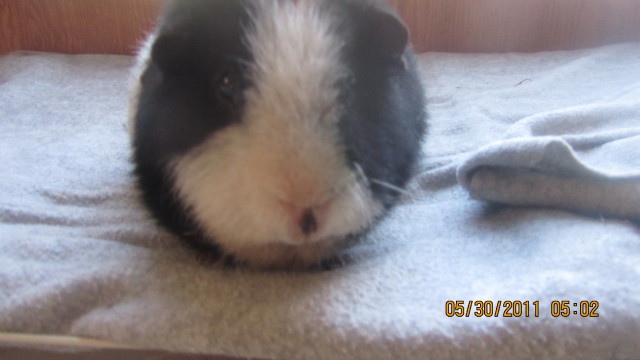 growth on my guinea pigs snout
QuestionQUESTION: Recently I noticed a growth on my 2 y
growth on my guinea pigs snout
QuestionQUESTION: Recently I noticed a growth on my 2 y
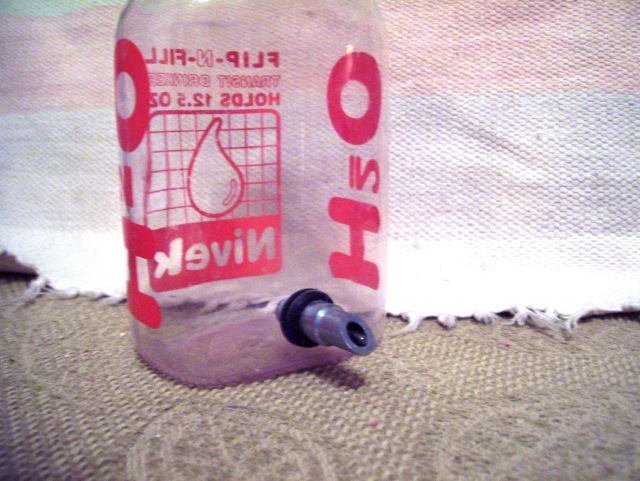 Water bottle
QuestionYou suggested we get a water bottle with a font
Water bottle
QuestionYou suggested we get a water bottle with a font
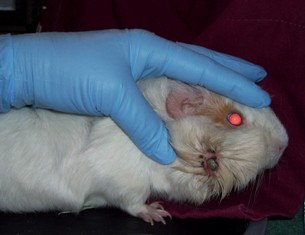 abscess is bleeding
QuestionHi Pat,
My guinea pig, Pogo, got an abscess a f
abscess is bleeding
QuestionHi Pat,
My guinea pig, Pogo, got an abscess a f
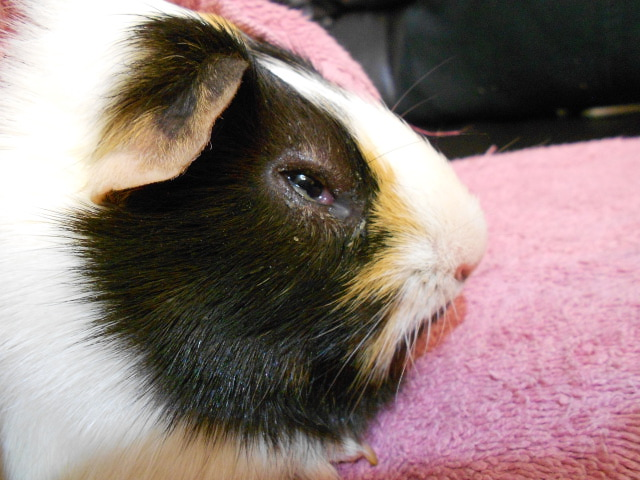 Possible Eye Infection?
Question
Right Eye Closer
About 2 days ago
Possible Eye Infection?
Question
Right Eye Closer
About 2 days ago
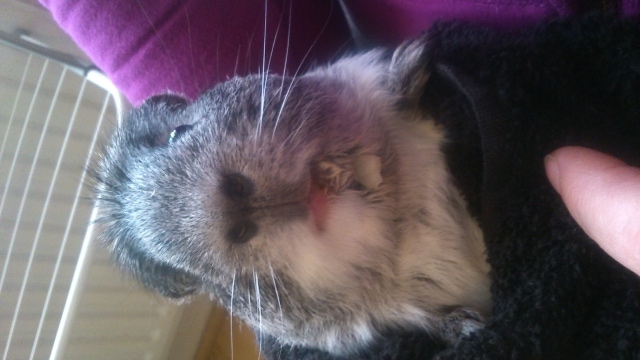 Guineau pig has odd glue like substance jutting out from neck
QuestionQUESTION: Hi, my little girls guineapig has a s
Guineau pig has odd glue like substance jutting out from neck
QuestionQUESTION: Hi, my little girls guineapig has a s